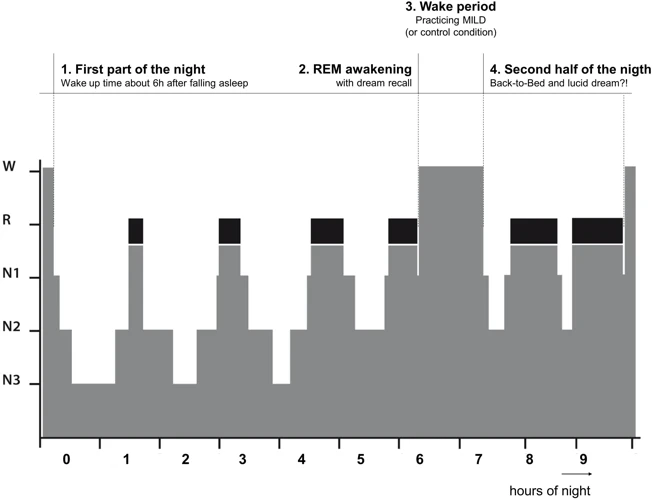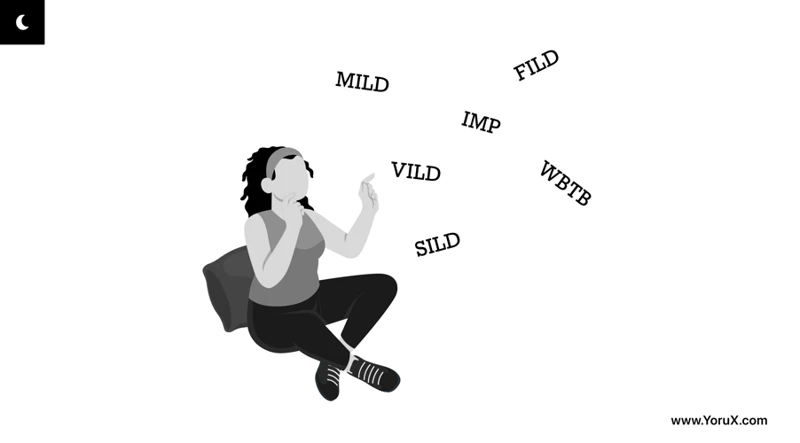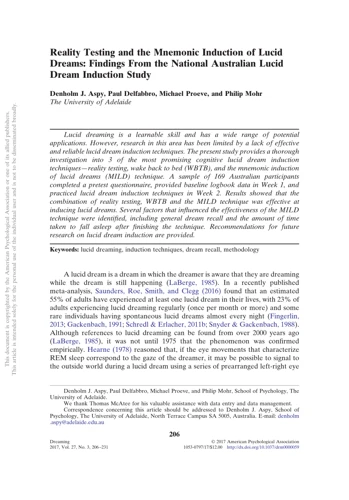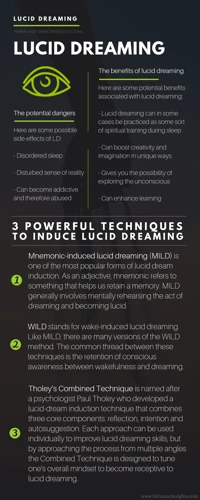Dreaming is a fascinating and mysterious aspect of our lives that has captured our imaginations for centuries. For some, lucid dreaming – the ability to consciously control your dreams – is the ultimate goal. One method of achieving lucid dreaming is through the Mnemonic Induction of Lucid Dreams (MILD) technique, which involves rehearsing the desire to become aware and in control during a dream. However, for maximum effectiveness, MILD can be combined with other dream recall techniques. In this article, we’ll explore the benefits and step-by-step process of combining MILD with other techniques for better results.
Contents
- What is MILD?
- Other Dream Recall Techniques
- Combining MILD with Reality Testing
- Combining MILD with Dream Journaling
- Other Techniques to Combine with MILD
- How to Incorporate These Techniques
- Common Challenges and Solutions
- Conclusion
-
Frequently Asked Questions
- How long will it take to see results from using MILD?
- What is the best time of day to practice MILD?
- Is MILD safe to use?
- Can MILD be used in combination with other techniques?
- Can anyone learn to lucid dream using MILD?
- What should I do if I have trouble remembering my dreams?
- Is MILD effective for everyone?
- Can MILD be used to control the content of dreams?
- Can MILD be used to prevent nightmares?
- Can MILD be done with a partner or in a group setting?
- References
What is MILD?

Mnemonic Induction of Lucid Dreams (MILD) is a popular lucid dreaming technique that involves training your mind to recognize when you are dreaming. It was developed by Dr. Stephen LaBerge, who is a renowned expert in the field of lucid dreaming.
How MILD Works
MILD works by creating a strong association between the act of recognizing that you are dreaming and the intention to have a lucid dream. This is done through a series of mental exercises that are designed to increase your self-awareness and conditioned reflexes.
Once you have trained your mind to recognize when you are dreaming, you can take control of your dreams and have the power to create or alter your dream world. This can lead to incredible experiences, such as flying, exploring different worlds or meeting your favorite celebrities.
Steps for Performing MILD
To perform MILD, follow these steps:
1. Set your alarm to wake you up at least five hours after you go to bed.
2. When the alarm goes off, get out of bed and do something that requires focused mental effort, such as reading a book or studying.
3. After 30-60 minutes, go back to bed and lie down in a comfortable position.
4. Before you fall asleep, repeat a phrase in your head, such as “I will realize that I am dreaming.” Visualize yourself becoming aware of your dream state.
5. Imagine yourself performing a reality check, such as looking at your hands. This helps to train your mind to recognize when you are dreaming.
6. Repeat the phrase and visualization until you fall asleep.
Benefits of MILD
MILD is a highly effective way to induce lucid dreams. Unlike other techniques that rely on external stimuli, such as light or sound, MILD is entirely mental and can be done anywhere, anytime. It is also relatively easy to learn and can be used by anyone, regardless of their experience with lucid dreaming. With regular practice, MILD can help you achieve incredible dream experiences that can enrich your life in unique ways.
How MILD Works
Understanding the inner workings of MILD may seem like a challenge at first, but it’s essential to know how this technique can help you achieve lucid dreaming. Using a combination of intention-setting, reality testing, and visualization, MILD targets the subconscious mind and helps it recognize when you’re in a dream state. By repeatedly affirming your intention to notice when you’re dreaming, you can train your mind to become more aware of the signs and symbols that signal the onset of a dream, ultimately leading to a higher likelihood of achieving lucidity. Let’s dive deeper into the steps involved in performing MILD and how they help improve dream recall and awareness.
Steps for Performing MILD
Performing the Mnemonic Induction of Lucid Dreams (MILD) technique involves several steps that can help improve the likelihood of having a lucid dream. These steps include:
| Step 1: | Fall asleep while repeating an affirmation in your head that you will become aware that you are dreaming. Choose a simple phrase such as, “I will realize I’m dreaming”. |
| Step 2: | When you wake up from a dream, try to recall as many details as possible to increase your dream recall ability. |
| Step 3: | Concentrate on the last dream you had and try to remember specific details such as places, people, and objects. |
| Step 4: | Visualize yourself becoming lucid within that dream, noticing what you would do once you realized you were dreaming. |
| Step 5: | Repeat your affirmation again before falling back to sleep, in order to program your mind to recognize when you are dreaming. |
| Step 6: | Throughout the day, practice questioning whether or not you are dreaming by doing a reality check. This reality check could be something simple such as looking at a clock and then looking away and back, and seeing if the time has changed. |
Note: It’s important to perform these steps consistently in order to see results. By regularly practicing MILD, you can increase your chances of having lucid dreams and in turn, gain more control over your dream experiences.
Other Dream Recall Techniques

Aside from MILD, there are a variety of other dream recall techniques that can be incorporated into your lucid dreaming practice. By combining these techniques with MILD, you can enhance your ability to remember and become lucid in your dreams.
Reality Testing: One popular technique that can be paired with MILD is reality testing. Reality testing involves regularly checking if you are in a dream or in waking reality. This is done by performing a simple action, such as attempting to push your hand through a solid object or looking at a clock, and then questioning whether or not you are dreaming. By incorporating reality testing into your MILD practice, you can heighten your awareness during the day and increase the likelihood of questioning your reality in your dreams.
Dream Journaling: Dream journaling involves writing down your dreams in as much detail as possible in a journal. This technique can be used to enhance dream recall and help identify recurring dream signs or patterns. By combining dream journaling with MILD, you can review your previous dreams before attempting to fall asleep using MILD. This can help prime your mind to recognize dream signs or patterns and increase your chance of becoming lucid in your dreams.
WBTB (Wake-Back-to-Bed): WBTB involves setting an alarm to wake up in the middle of the night and staying awake for a short period of time before returning to sleep. This technique can help increase the likelihood of becoming lucid in a dream as it involves entering a dream directly after a period of wakefulness. By incorporating WBTB with MILD, you can use the wakeful period to perform the MILD technique before returning to sleep.
Visualization: Visualization involves visualizing yourself becoming lucid in your dreams and imagining the details of your desired dream scenario. By practicing visualization in conjunction with MILD, you can reinforce your intention to become lucid and increase your ability to recognize when you are in a dream.
Meditation: Meditation can help increase focus and decrease anxiety, which can be beneficial for lucid dreaming. By practicing meditation before bed, you can help calm your mind and promote a state of relaxation conducive to lucid dreaming.
When incorporating these techniques with MILD, it’s important to create a routine that works for you. Gradual implementation, such as adding one technique at a time, can help prevent an overwhelming feeling. Over time, combining these techniques with MILD can enhance your ability to become lucid in your dreams.
Reality Testing
One technique that many lucid dreamers swear by is the practice of reality testing. This technique involves regularly questioning whether you are dreaming or awake, and performing certain tests to differentiate between the two states. These reality tests can trigger one’s awareness and improve the likelihood of recognizing a dream state. However, it may take some experimentation to find the most effective approach to reality testing. Let’s explore how this technique can be used in combination with MILD for even greater lucid dreaming success.
Dream Journaling
Dream journaling is a popular technique used for improving dream recall. Keeping a journal alongside MILD can help maximize its effectiveness. This technique involves recording your dreams as soon as you wake up, while the details are still fresh in your mind.
To effectively practice dream journaling, follow these steps:
- Prepare your materials: Keep a notebook and pen or pencil next to your bed. Alternatively, you can use a dream journal app on your phone or tablet.
- Record your dreams: As soon as you wake up, jot down any details you remember from your dreams. Don’t worry about writing in a coherent manner, just record whatever comes to mind. If you can’t remember any details, simply write “no dreams.”
- Review your journal: Take some time to read through your dream journal and look for recurring themes or patterns. This can help you identify your dream signs, which are certain cues or events that occur frequently in your dreams.
By incorporating dream journaling with MILD, you are training your brain to pay more attention to your dreams. You are also giving yourself a better chance of recognizing and remembering the dream signs that will help trigger lucidity during your dreams.
Benefits of combining MILD with Dream Journaling include:
- Increased dream clarity and recall.
- Deeper understanding of your dream patterns and themes.
- Increase in your ability to identify your dream signs.
- Better recall and recognition of any recurring dream characters.
Dream journaling is an essential tool for anyone looking to improve their dream recall, and when used alongside MILD, it can significantly increase your chances of achieving lucidity in your dreams.
Combining MILD with Reality Testing

Using Reality Testing, or regularly checking if you are dreaming during waking hours, can increase the likelihood of recognizing when you are in a dream state. By combining Reality Testing with MILD, you can improve your ability to have lucid dreams.
How to Use Reality Testing with MILD: Begin incorporating Reality Testing into your daily routine, trying to do a reality check every time you see a certain object or perform a specific action. Before falling asleep, focus on the idea that you will recognize a dream by performing a reality check while dreaming.
Benefits of Combining the Techniques: By being in the habit of reality checking during waking hours, you are also more likely to do so in your dreams. This can lead to increased self-awareness during dreaming and a higher chance of realizing that you are dreaming, which is necessary for lucid dreaming.
Other benefits of combining MILD with Reality Testing include increased focus and a more structured approach to achieving lucid dreams. The routine of performing reality checks during waking hours can also help you stay more engaged and motivated in your lucid dream practice.
Combining MILD with Reality Testing can be an effective way to increase your chances of having lucid dreams. By making reality checking a habit and focusing on the idea of recognizing a dream state while falling asleep, you can improve your self-awareness and have more control over your dreams.
How to Use Reality Testing with MILD
When it comes to lucid dreaming techniques, combining multiple methods can lead to even more effective results. One type of technique that can be combined with the MILD method is reality testing, which involves performing checks throughout the day to determine whether or not you are dreaming. By incorporating this technique into your MILD routine, you can enhance your ability to recognize when you are in a dream and increase your chances of achieving lucidity. But how exactly can you use reality testing in conjunction with MILD? Let’s take a closer look.
Benefits of Combining the Techniques
By combining MILD with other dream recall techniques such as reality testing and dream journaling, you can significantly increase your chances of having a lucid dream. Let’s explore some of the benefits of incorporating these techniques into your routine.
| Benefits of Combining MILD with Reality Testing: |
|---|
| Increased Self-Awareness: When you perform reality tests throughout the day, you become more aware of your surroundings and your own mental state. This increased awareness can carry over into your dreams, making it easier to recognize when you are dreaming. |
| Improved Reality Checks: Performing reality tests regularly can help you fine-tune your technique and make it more effective. This can lead to more lucid dreams and a better overall dream recall. |
| Greater Confidence: By using reality testing in conjunction with MILD, you may feel more confident and in control of your ability to have lucid dreams. |
| Benefits of Combining MILD with Dream Journaling: |
|---|
| Better Dream Recall: Keeping a dream journal can help enhance your ability to remember your dreams. By writing down your dream experiences immediately upon awakening, you can increase your conscious awareness of them and recall more details. |
| Improved Dream Analysis: Dream journaling can also help you identify recurring patterns or themes in your dreams, which can be useful for determining your dream signs and enhancing your reality testing technique. |
| Deeper Reflection: By taking the time to reflect on your dreams through journaling, you may be able to gain deeper insights into your own subconscious mind and emotional state. |
By combining MILD with other techniques like reality testing and dream journaling, you can create a powerful dream recall routine that increases your self-awareness, improves your dream recall, and helps you gain insights into your own psyche. These benefits can help you have more frequent and vivid lucid dreams, putting you more firmly in control of your dream experiences.
Combining MILD with Dream Journaling

One technique that is often used in combination with MILD is dream journaling. Dream journaling involves keeping a record of your dreams upon waking up. The idea behind this technique is that it helps improve dream recall and ability to recognize dream signs. By recording your dreams, you are training your brain to pay closer attention to the details of your dreams.
To use dream journaling with MILD, you should keep a notebook or a journal near the bed. As soon as you wake up from a dream, write down as many details as you can remember. It’s important to record not only the events of the dream but also your emotions, thoughts, and sensations experienced during the dream.
Additionally, before going to bed, you should review your dream journal and identify any recurring dream signs or themes that show up in your dreams. These dream signs can be used as a focus for your MILD technique.
Combining MILD with dream journaling can be highly effective in improving dream recall and inducing lucid dreams. Dream journaling helps develop greater self-awareness, which in turn can help you become more alert to the fact that you are dreaming. This increased self-awareness can lead to more frequent lucid dreams.
Using MILD while focusing on specific dream signs from your journal can help train your brain to recognize when you are dreaming more easily. This can enhance the effectiveness of the MILD technique and increase the likelihood of having a lucid dream.
Dream journaling is a valuable tool for anyone interested in lucid dreaming, and when combined with the MILD technique, can be even more effective in increasing the frequency of lucid dreams.
How to Use Dream Journaling with MILD
As we learned in the previous section, MILD technique involves actively visualizing a dream and setting an intention to remember it in order to increase the likelihood of becoming lucid within that dream. However, combining MILD with other techniques can further enhance its effectiveness. One such technique is dream journaling. By maintaining a record of dreams and reflecting on them, dreamers can gain insight into their patterns and triggers, as well as improve overall dream recall. In this section, we will explore how to incorporate dream journaling into MILD for optimal results.
Benefits of Combining the Techniques
By combining the MILD technique with either reality testing or dream journaling, dreamers may experience a greater likelihood of success in achieving lucid dreams. The following table outlines the benefits of incorporating each technique into a MILD routine:
| Technique | Benefits |
|---|---|
| Reality Testing | – Increases self-awareness – Helps identify dream signs – Improves overall dream recall – Increases chance of achieving lucid dreams |
| Dream Journaling | – Improves dream recall – Helps identify dream signs – Allows for reflection on dream content – Increases chance of achieving lucid dreams |
Combining these techniques with MILD can also create a more structured and intentional approach to lucid dreaming. By incorporating reality testing or dream journaling into a regular MILD routine, dreamers are able to stay focused and engaged with their lucid dreaming goals.
Utilizing multiple techniques can address any individual limitations or challenges with one method alone. For example, if one struggles with remembering dreams, incorporating dream journaling may significantly improve dream recall and increase the chance of lucidity.
By combining the MILD technique with other dream recall techniques, dreamers can potentially enhance their chances of achieving lucid dreams and have a more fulfilling lucid dreaming experience.
Other Techniques to Combine with MILD

Besides reality testing and dream journaling, there are several other techniques that you can combine with MILD to increase your chances of having lucid dreams. These techniques include WBTB (Wake-Back-to-Bed), visualization, and meditation.
WBTB (Wake-Back-to-Bed)
WBTB is a technique that involves waking up in the middle of the night, staying awake for a short period, and then going back to sleep. This technique is often used in combination with MILD because it helps increase the likelihood of having lucid dreams during the second half of the night, which is when most REM sleep occurs.
To use WBTB with MILD, set an alarm for 4-6 hours after initially going to sleep. When the alarm goes off, get out of bed and stay awake for 15-30 minutes. During this time, practice MILD by visualizing yourself becoming aware that you are dreaming and repeating your mantra. Then, go back to bed and continue to repeat your mantra until you fall asleep.
Visualization
Visualization is a technique that involves using mental imagery to create a specific outcome or desired result. When used in combination with MILD, visualization can help increase your chances of having a lucid dream.
To use visualization with MILD, spend a few minutes before bed creating a mental image of yourself becoming aware that you are dreaming. Imagine yourself performing reality checks and recognizing that you are in a dream. Then, as you practice MILD, incorporate this mental image into your visualization.
Meditation
Meditation is a relaxation technique that can help calm your mind and increase your focus. When used in combination with MILD, meditation can help you relax before bedtime, making it easier to fall asleep and have lucid dreams.
To use meditation with MILD, begin by finding a quiet place to sit or lie down. Close your eyes and focus on your breathing, taking deep, slow breaths. As you breathe, clear your mind of any thoughts or distractions. Once you feel relaxed, begin to practice MILD, repeating your mantra and visualizing yourself becoming aware that you are dreaming.
How to Incorporate These Techniques
To incorporate these techniques into your MILD practice, start by choosing one or two that appeal to you. Then, create a routine that includes these techniques along with your MILD practice. For example, you might begin by practicing meditation for 10-15 minutes before bedtime, followed by MILD and visualization.
Creating a Routine
To create a routine that works for you, experiment with different techniques and practice them consistently over time. This will help you develop a habit of lucid dreaming and improve your chances of success.
Gradual Implementation
It’s important to note that you don’t have to implement all of these techniques at once. Instead, start by incorporating one or two techniques and gradually add more as you become more comfortable with the practice.
Common Challenges and Solutions
Some common challenges that you may encounter when combining these techniques with MILD include difficulty remembering your dreams and feeling overwhelmed by the routine. To overcome these challenges, try keeping a dream journal to improve dream recall and simplify your routine by focusing on one or two techniques at a time.
Conclusion
By combining MILD with other dream recall techniques, you can increase your chances of having lucid dreams and gain greater control over your dream experiences. Remember to experiment with different techniques and be patient with yourself as you develop a routine that works for you. With consistent practice and dedication, you can master the art of lucid dreaming and enjoy all of its benefits.
WBTB (Wake-Back-to-Bed)
One intriguing technique that has gained popularity among lucid dreamers is the idea of interrupting your sleep in the middle of the night to increase the likelihood of having a lucid dream. This method is known as the Wake-Back-to-Bed (WBTB) technique. It may seem paradoxical to deliberately wake up in the middle of the night to facilitate better sleep, but many lucid dreamers swear by the effectiveness of this technique. Let’s delve deeper into how this technique works, and how it can be combined with MILD to improve your chances of having lucid dreams.
Visualization
One technique that can be combined with MILD for better results is visualization. This technique involves creating a clear mental image of what you want to achieve, in this case, having a lucid dream.
To incorporate visualization into your MILD practice, take a few minutes before bed to visualize yourself becoming aware that you are dreaming. Picture yourself noticing something unusual in your dream and realizing that you are in fact dreaming. Imagine how it would feel to be fully aware that you are dreaming and the excitement that you would experience.
By visualizing yourself having a lucid dream, you are setting a clear intention for your mind to follow. This can help to reinforce the idea that becoming lucid is a goal that is important to you, increasing the likelihood of success.
Additionally, visualization can be used in conjunction with reality testing. For example, imagine yourself checking if you are dreaming during the day and then experiencing success. This can help to make reality testing feel more natural and automatic, increasing the chances of it carrying over into your dreams.
It is important to note that visualization is not a guaranteed method for inducing lucid dreams. However, when combined with other techniques like MILD, reality testing, and dream journaling, it can be a powerful tool for increasing your chances of becoming lucid.
| Technique | Steps |
|---|---|
| MILD | 1. Set intention to remember dreams 2. Repeat mantra before sleep 3. Visualize becoming aware in dream |
| Reality Testing | 1. Choose a reality check 2. Perform check throughout day 3. Question reality during check |
| Dream Journaling | 1. Record dreams upon waking 2. Identify patterns and dreamsigns 3. Reflect on dream content |
| Visualization | 1. Picture becoming aware in dream 2. Imagine the feeling of lucidity 3. Visualize success with reality testing |
Meditation
Meditation can be a powerful tool when combined with MILD for lucid dreaming. By calming the mind and reducing stress, meditation can improve overall dream recall and create a more receptive state of mind for inducing lucid dreams.
Benefits of Meditation for Lucid Dreaming
Meditation has numerous benefits that can aid in the practice of lucid dreaming. Here are some of the main advantages of incorporating meditation into your lucid dreaming routine:
- Stress Reduction: Meditation is known for its ability to reduce stress and anxiety, which can be a major hindrance to lucid dreaming. By practicing meditation regularly, you may find it easier to enter a relaxed and receptive state that is conducive to lucid dreaming.
- Improved Concentration: Meditation can also help improve your focus and attention, which are important skills for inducing lucid dreams. By training your mind to stay present and focused, you may find it easier to recognize the dream state and become lucid.
- Heightened Awareness: Meditation can also enhance your awareness and sensory perception, which are key factors in becoming aware that you are dreaming. By practicing meditation regularly, you may become more aware of the subtle sensations and details of your waking life, which can transfer over into your dreams.
- Deeper Sleep: Finally, meditation can also help improve the quality of your sleep, which is essential for lucid dreaming. By entering a deep and restful state, you may find it easier to enter the REM stage of sleep, where most vivid dreams occur.
Types of Meditation to Try
There are many different types of meditation to choose from, each with its own benefits and techniques. Here are some of the most popular types of meditation for lucid dreaming:
| Type | Description |
|---|---|
| Mindfulness Meditation | A type of meditation that involves staying present and attentive to your thoughts and sensations without judgment. This can be helpful for improving overall awareness and focus. |
| Transcendental Meditation | A type of meditation that involves using a mantra or sound to quiet the mind and enter a deep meditative state. This can be helpful for reducing stress and improving sleep quality. |
| Loving-Kindness Meditation | A type of meditation that involves cultivating feelings of love, compassion, and kindness towards yourself and others. This can be helpful for reducing negative emotions and improving overall wellbeing. |
| Visualization Meditation | A type of meditation that involves visualizing a calming image or scenario in your mind. This can be helpful for reducing stress and anxiety and creating a more receptive state for lucid dreaming. |
Combining Meditation with MILD
To combine meditation with MILD, you can try practicing meditation right before bed or during a WBTB (wake-back-to-bed) period. Use the techniques you’ve learned from meditation to enter a relaxed and receptive state, and then begin your MILD practice. Keep a clear intention in mind and repeat your mantra or visualization as you drift off to sleep.
Gradual Implementation
If you’re new to meditation or MILD, it’s important to take a gradual approach to incorporating these techniques into your routine. Start by practicing each technique separately and then gradually incorporate them into your routine over time. Be patient and persistent, and don’t give up if you don’t see immediate results. With practice and dedication, you’ll be on your way to experiencing more vivid and lucid dreams.
How to Incorporate These Techniques

Incorporating various dream recall and lucid dreaming techniques can be overwhelming, but it is important to create a routine and gradually implement these techniques. Here are some tips on how to do it effectively:
Creating a Routine: Incorporating these techniques must become a consistent practice. Establish a set schedule for performing the techniques, such as every night before bed, and every morning upon waking. Consistency strengthens the habit, which will increase the chances of success.
Gradual Implementation: It is important to gradually incorporate these techniques into your daily routine. Begin with implementing one or two at a time, versus trying to incorporate all of them at once. This allows better focus on a few techniques, increasing the chances of success.
Difficulty Remembering Dreams: For those who face difficulty remembering their dreams, ‘Reality Testing’ and ‘Dream Journaling’ can be useful tools. Reality testing helps to discern between the real world and the dream world, and dream journaling records the dreams in detail, aiding in dream recall.
Overwhelming Routine: Implementing multiple dream recall techniques simultaneously can be overwhelming. Instead of giving up, focus more on one or two techniques that resonate better with you. Gradual implementation allows focussed and effective practice.
Creating a Routine
Developing a consistent routine is crucial when it comes to lucid dreaming. It may seem overwhelming at first, but establishing a set of habits and techniques can significantly increase the likelihood of achieving a lucid dream. In this section, we will explore the different methods for creating a routine that works for you and discuss how it can improve your lucid dreaming experience. So, let’s dive into the details and start crafting your personal lucid dream routine!
Gradual Implementation
Implementing multiple techniques at once can be overwhelming and may not produce the desired results. That’s why it’s important to gradually incorporate these techniques into your routine. Here are some steps you can take:
| Step | Action |
|---|---|
| Step 1 | Start with MILD as the foundation of your routine. Practice it regularly until you start seeing results. |
| Step 2 | Add one technique at a time. For example, practice MILD and reality testing for a week or two before incorporating dream journaling. |
| Step 3 | Once a technique becomes a habit, add the next one. |
| Step 4 | Continue to practice all the techniques regularly. However, if you find that a certain technique is not working for you, feel free to remove it from your routine and try something else. |
Remember, the key is to take it slow and give each technique enough time to show results. With patience and persistence, you’ll be able to incorporate these techniques into your routine and achieve better dream recall and lucidity.
Common Challenges and Solutions
One of the biggest challenges when it comes to lucid dreaming is the difficulty in remembering dreams. This can be especially problematic when trying to use MILD or other dream recall techniques. If you find yourself struggling to remember your dreams, there are a few solutions that may help.
Difficulty Remembering Dreams: One solution is to keep a dream journal next to your bed. If you wake up in the middle of the night, jot down any dream fragments you can remember. If you don’t remember anything, write down “no dream recalled”. Over time, this will help train your brain to remember more of your dreams.
Another solution may be to incorporate certain supplements or foods into your diet that are known to aid in dream recall. Some examples include B6 vitamins, mugwort, and valerian root. However, be sure to consult with a healthcare professional before trying any new supplements.
Overwhelming Routine: Another common challenge is feeling overwhelmed with the amount of techniques and routines that need to be implemented in order to have a successful lucid dream. However, it’s important to remember that everyone’s journey to lucid dreaming is unique and you should only incorporate techniques and routines that work for you.
To combat overwhelm, start with a few simple techniques and gradually add more as you become comfortable. For example, start with MILD and dream journaling, and then add in WBTB or visualization as you see fit. It’s also important to be patient and consistent in your practice, as lucid dreaming can take time and practice.
While there may be common challenges when it comes to lucid dreaming, there are also effective solutions. By implementing a consistent practice and finding what works for you, you can overcome these challenges and have successful lucid dreams.
Difficulty Remembering Dreams
For some, the biggest challenge with lucid dreaming is not achieving the state itself, but rather, remembering the details of their dreams. The inability to recall dreams makes it difficult to track progress and achieve lucidity, even with the help of MILD and other techniques. It’s frustrating to wake up with a vague sense of unease, knowing that you dreamt about something significant but unable to remember any specifics. However, there are solutions available to improve dream recall and increase the chances of a successful lucid dream.
Overwhelming Routine
It’s natural to feel overwhelmed when adopting a new routine, especially one that involves multiple techniques like MILD, reality testing, dream journaling, WBTB, visualization and meditation. However, with the right strategies, you can make the routine more manageable and sustainable in the long run.
Strategy | Description
— | —
Slow Progression | Don’t overwhelm yourself by trying to implement every technique all at once. Instead, gradually incorporate them into your routine over time to help you adjust.
Flexibility | Your routine doesn’t have to be set in stone. Be open to adjusting it as needed to fit your schedule and lifestyle.
Prioritization | Identify which techniques are the most effective for you, and prioritize those. For example, if dream journaling is more beneficial than visualization, prioritize the former.
Accountability | Share your routine with someone who can hold you accountable and provide support when you need it. This could be a friend, family member, or even an online community of lucid dreamers.
Keep in mind that the ultimate goal is to find a routine that works for you. It’s okay to experiment with different techniques and strategies until you find what’s most effective. With persistence and dedication, you can overcome the overwhelming feeling and achieve lucid dreams more consistently.
Conclusion
In conclusion, combining MILD with other dream recall techniques can greatly improve the chances of having lucid dreams. By using reality testing and dream journaling with MILD, dreamers can better establish the habit of questioning their reality and improving their dream recall. Additionally, incorporating other techniques such as WBTB, visualization, and meditation can help even further.
It is important to create a consistent routine that gradually includes these techniques. This will prevent overwhelm and make it easier to establish the habit. It is also important to address common challenges such as difficulty remembering dreams and an overwhelming routine.
With patience and perseverance, combining these techniques can lead to incredible results in the world of lucid dreaming. The possibilities for exploration and personal growth are endless. So go forth, and keep dreaming!
Frequently Asked Questions
How long will it take to see results from using MILD?
Results can vary and may take some time, but with regular practice and consistency, you may begin to see results within a few weeks to a month.
What is the best time of day to practice MILD?
The best time to practice MILD is during a natural awakening in the middle of the night, but it can also be done during daytime naps or before going to bed at night.
Is MILD safe to use?
MILD is a safe and natural technique that involves using the power of the mind to enhance dream recall and promote lucid dreaming.
Can MILD be used in combination with other techniques?
Absolutely! MILD can be combined with other techniques such as reality testing, dream journaling, visualization, and meditation for even better results.
Can anyone learn to lucid dream using MILD?
Yes, with time and practice, anyone can learn to lucid dream using the MILD technique and other dream recall techniques.
What should I do if I have trouble remembering my dreams?
If you have trouble remembering your dreams, try setting the intention to remember before going to sleep and keeping a dream journal nearby to record any fragments that come to mind upon waking.
Is MILD effective for everyone?
The effectiveness of MILD can vary from person to person, but it can be a useful tool for anyone looking to improve their dream recall and potentially experience lucid dreaming.
Can MILD be used to control the content of dreams?
No, MILD does not involve controlling the content of dreams but rather enhancing the ability to remember and potentially become aware during the dream state.
Can MILD be used to prevent nightmares?
MILD is not specifically aimed at preventing nightmares, but it can potentially help individuals become more aware and in control of their dreams, which may result in less stressful dream experiences.
Can MILD be done with a partner or in a group setting?
Although MILD can be done individually, it can also be done with a sleeping partner or in a group setting for added support and motivation.







